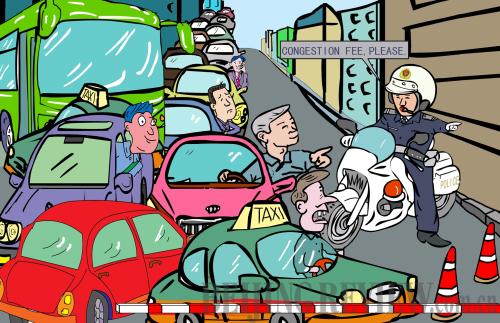|
 |
|
(LI SHIGONG) |
The government of Beijing announced in a press conference in early September that the city is planning to collect rush hour fees in the coming years, an attempt to relieve increasingly serious traffic congestion.
Due to the rapid development of China's auto industry and market, the number of cars in downtown Beijing has increased sharply within just a few years. Meanwhile, traffic infrastructure construction is far outpaced by the wild growth of vehicles. In order to improve local traffic conditions and smooth traffic flows, particularly in rush hour, Beijing is to implement a series of new traffic regulations, including the collection of rush hour fees.
Rush hour fees are not a new idea. In 2007, the coastal city of Shenzhen in south China's Guangdong Province attempted to collect such fees to ease traffic jams during peak hours. The city discussed charging the fees again in March this year, but still failed to implement it because of the controversy it provoked.
The decision of Beijing to collect congestion fees once again put the topic in press headlines. Jiang Kejun, a researcher with the National Development and Reform Commission, said that now is not an ideal time for Beijing to collect rush hour fees because public transportation has not been improved to meet the demand. Drivers also have concerns that congestion fees will aggravate their burden of owning a car. The following are excerpts of some opinions:
Supporters
Zhong Nanshan (www.sina.com.cn): Collecting rush hour fees is a kind of administrative interference, and in the long run, it will help to greatly ease traffic jams. In addition, fumes from car exhaust are a major cause of PM 2.5 pollution. When this fee is implemented, drivers will be discouraged from flooding the streets. Thus, I support the collection of this fee.
Cui Dongshu (China Youth Daily): Issuing rush hour fees is a reasonable tool to control traffic jams—more effective than the limits on car purchases. Today, Beijing's downtown area is already unable to support the increase of cars. Besides, congestion fees will not affect Beijing's auto market, because it is only imposed on the downtown area. The limit of using cars will not discourage people from buying vehicles.
Zhang Zhiyong (China Youth Daily): Compared with the current policy of car purchase limitations and restricted driving, collecting rush hour fees is more reasonable. If it is properly handled, traffic congestion and environmental pollution can be better addressed. Restricting the purchase of cars not only is unfair but also will affect the development of the auto industry and even the tourism industry. On the contrary, traffic congestion fees will not.
Opponents
Luo Xu (Dazhong Daily): South Korea began to collect rush hour fees in Seoul as early as 1996. Some experts in the country have said that since the fee began to be collected, average travel time has greatly reduced. Though the fee charge policy was successful in Seoul, we must still ask whether a policy suitable for South Korea will suit China as well.
One thing is certain: South Korea has fewer official cars than China, not only in terms of the total number, but also in terms of the average number per capita. It is a conservative estimate that China owns around 3.5 million official vehicles. Today, local governments' official car expenses are increasing at a pace of 20 percent every year. What I want to stress is that these official cars depend on public expenses, so they will not be affected by the collection of rush hour fees.
In the late 1990s, London began to push forward the scheme of rush hour fees. Up to now, London has collected a total of £800 million ($1.28 billion), but the city's traffic congestion remains terrible.
When London, a city of far fewer official cars, fails to solve traffic congestion by collecting these fees, how can we expect China—a country of a huge number of official cars—to solve this problem using similar means?
Actually, some experts have already pointed out that curbing the number and growth of official cars is an effective way to relieve traffic pressure on city roads. This is also a common practice elsewhere in the world.
For example, in South Korea, there were once 2.78 million cars. In order to solve the problem of traffic congestion and limited parking, the municipal government of Seoul started a reform of official cars. When Seoul's total official cars decreased to 47, the city's traffic congestion was effectively eased. Seoul's traffic problem was solved by means other than rush hour fee collection. So, in China the first step to solving the traffic congestion problem in cities is to control official cars, rather than rely on fees.
| 